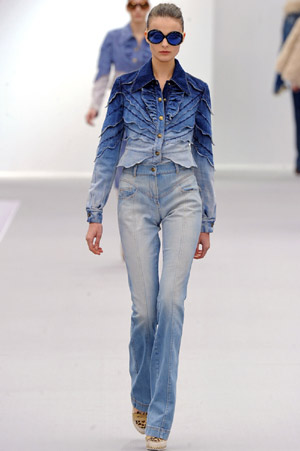國際著名女星莫妮卡?貝魯奇曾經(jīng)說過“性感的不是我,是意大利”。這句話足見意大利的風(fēng)情。無數(shù)世界頂級的時尚品牌皆出于意大利,米蘭時裝周更被視為世界潮流的風(fēng)向標(biāo)。在意大利,時尚早已成為一種文化,而非名人、富人的專利,在這個浪漫、個性化的國家里,時尚已經(jīng)融入到人們的生活中。

By Damyanti Ghosh
卓言 選 王雪嬌 譯
|
Looking good in Italy is a national obsession. Forget football, fast cars and food. This nation’s favourite pastime is style. Italians grow up in a culture of “bella figura”. This translates literally as “beautiful figure” but is more specifically understood as “a good image”. This is not only related to what you wear but involves how you “appear”: etiquette, reputation, style are all equally important. The way you present yourself to the world matters hugely. In a country where, even the police uniforms are designed by Valentino and footballers are kitted out by Mr. Armani, Italians consider it essential to look good pretty much from birth. This is not a new phenomenon and is in no way related to individual finances. Indeed, a little bit of style in Italy can take you a very long way. For Italians style is cultural democracy; in the words of Italy’s most famous journalist, Luigi Barzini, “where poverty can be worn with dignity... it is not noticeable or embarrassing”. In times of national and international disaster, Italians can be relied on to put their best fashion foot forward. When the first tourists arrived in Italy after WWII, they were stunned at the importance placed on fashion by the young men and women lounging in the bars and cafés of Rome. One observer commented, “Some of them would go without eating to devote the few pennies they had to buying suits, shirts and dresses which would enable them to cut a dignified figure at the passeggiata.” Italians seem to be quite happy to sacrifice comfort for style and elegance. And they insist on attention to detail. Never have I seen an Italian with a missing button on their suit, a hem falling down or sporting an unpressed outfit. I have also never seen an Italian woman in a pair of trainers. These impressive signorinas tackle the most gnarly of cobblestones in high heels with the grace of a gazelle and the determination of an Olympic athlete. Perhaps this is only to be expected. Italy is, of course, the shoe capital of the world. Style and function are inseparable in Italy and this is reflected in attitudes to dress. Italians favour well-tailored cuts in neutral colours like black, white, beige and navy. Natural fabrics reign supreme and showing too much flesh is considered déclassé. As Sophia Loren said, “A woman’s dress should be like a barbed-wire fence: serving its purpose without obstructing the view.” For a slice of la dolce vita, add a couple of dresses to your core wardrobe. You should treat yourself to a shirtdress, a shift dress and an archetypal little black dress. The first two will cover all bases whether at work or play. Both can be dressed up or down; try a beautifully-stamped Italian leather belt to cinch in the waist of your shirt dress or a little cashmere cardigan to drape over the shoulders of your shift. You can go anywhere: from drinks at Harry’s Bar in Rome, dinner at Cipriani in Venice to a delicious ice cream at Cova in Milan. A well-cut suit is a worthwhile investment. If you choose wisely, you will be able to wear the jacket and trousers as separates, which makes a careful wardrobe choice go a long way. Any trouser style will do: cigarette pants for those long of leg, highwaisted for the fashionistas among you or tapered if you prefer a more classic silhouette. The key is in the cut. Make sure the suit fits you like a dream and if it doesn’t take it to a tailor—a true Italian will not suffer an ill-fitting outfit. Accessories are where you make your personal mark. A jewel-coloured scarf, an iridescent silk blouse, a neon pump, some understated yet fabulous jewellery; Italians prefer to personalise with details. Logos are out. The only thing worth advertising is yourself. Italian designers have been hailed the world over since the heady, stylised days of Elsa Schiaparelli. Referred to by Coco Chanel as “the Italian artist who makes clothes”, Schiaparelli loved to juxtapose colours, textures and silhouettes and is often acknowledged as the designer’s designer. More recently the houses of Prada, Gucci, Fendi, Missoni, Versace, Valentino, Armani and Cavalli have dominated the fashion headlines. Whether it is the subdued chic of Armani or the extravagant glamour of Cavalli, Italian designers retain their pole position at the top of the fashion world’s radar. |
追求光鮮體面的外表是意大利人癡迷的執(zhí)念。忘掉足球、快車和美食吧,這個國家最熱衷的消遣是時尚。意大利人生長在bella figura的文化中,這一詞直譯是指“迷人的身姿”,但更常被理解為“良好的形象”。這不僅僅與你穿什么有關(guān),而是指你“看上去”怎么樣:禮節(jié)、名聲、時尚都同樣重要。用何種方式向世人呈現(xiàn)自己極為關(guān)鍵。在意大利,就連警察制服都是由瓦倫蒂諾設(shè)計的,連足球運(yùn)動員的行頭都由阿瑪尼先生親自打造,意大利人自打出生開始就認(rèn)為保持良好形象是最基本的。 這可不是什么新鮮事,也無關(guān)個人財富的多少。實際上,在意大利一點點時尚就可以發(fā)揮很大作用。對意大利人來說時尚就是文化民主,用意大利最著名的新聞記者路易吉?巴津的話來說,“窮人也可以穿的很體面……這并不會惹人側(cè)目或令人尷尬”。即使在國家或國際上遭受災(zāi)難的時期,意大利人也絕不會停止追求完美時尚的腳步。第二次世界大戰(zhàn)后,當(dāng)?shù)谝慌慰蛠淼揭獯罄麜r,他們不禁驚訝于那些在羅馬酒吧和咖啡館里消磨時間的青年男女竟如此重視時尚。一個游客評論說,“有的人甚至不吃飯也要拿剩下的那點兒錢去買套裝、襯衫和禮服,以便在散步時表現(xiàn)出體面的形象。” 意大利人似乎非常愿意為時髦與優(yōu)雅而舍棄舒適,而且他們堅持對細(xì)節(jié)的關(guān)注。我從未見過一個意大利人的衣服缺紐扣、縫邊脫線,或是穿著沒熨過的服裝招搖過市。我也從未見過意大利女人穿休閑運(yùn)動鞋。這些迷人的小姐們用瞪羚似的優(yōu)雅和奧運(yùn)選手一般的意志穿著高跟鞋征服腳下最為“艱險”的鵝卵石路。或許這恰恰是我們所期待的。意大利,當(dāng)然,是世界鞋履之都。 在意大利,時尚與功能是分不開的,這一點也體現(xiàn)在對待穿著的態(tài)度上。意大利人喜歡剪裁講究、顏色中性化的衣服,比如黑色、白色、米色和海軍藍(lán)。天然針織品占絕對優(yōu)勢,穿著太過暴露會讓人覺得品位降低。正如索菲亞?羅蘭說的,“一個女人的衣服應(yīng)該像一張帶刺的鐵絲柵欄:既發(fā)揮了應(yīng)有的作用,又不會遮擋住里面的風(fēng)景”。為了你的甜蜜生活,在主衣櫥里添置幾件衣服吧:你應(yīng)該為自己準(zhǔn)備一件襯衫式連衣裙、一件直筒連衣裙和一件基本款的小黑裙。前兩者適用于任何場合,無論是工作還是娛樂。這兩件裙子既可外穿也可內(nèi)搭:在襯衫式連衣裙的腰際束一條帶有精美印花的意大利皮帶,或者在直筒連衣裙的外面披上一件短款對襟羊絨衫。基本款的小黑裙更是百搭:無論是去羅馬的Harry酒吧喝酒、在威尼斯的Cipriani餐廳用餐,還是在米蘭的Cova餐廳享受美味的冰淇淋。 一套款式精致的服裝絕對值得投資。如果選擇夠明智,你還可以配穿不成套的夾克和褲子,這樣,即使簡單的衣櫥也可以發(fā)揮很大作用。任何褲裝款式都可以:煙管褲適合腿長的人;高腰褲適合時尚達(dá)人;如果你喜歡傳統(tǒng)樣式則可以選擇錐形褲。關(guān)鍵在于款式。要確定這套服裝完全適合你,如果不合身,就拿到裁縫那兒去修改,一個真正的意大利人是絕不會將就一套不合身的衣服的。 配飾則可以體現(xiàn)你的個人風(fēng)格。一條寶石顏色的圍巾、一件彩虹色的絲綢罩衫、一雙亮色淺口鞋、幾樣低調(diào)卻奢華的珠寶,意大利人喜歡在細(xì)節(jié)處體現(xiàn)個人風(fēng)格。 名牌標(biāo)識已經(jīng)過時了。唯一值得宣傳的就是你自己。自從艾爾薩?夏帕瑞麗開創(chuàng)的任性、極具風(fēng)格的時代起,意大利設(shè)計師就一直在引領(lǐng)著世界潮流。被可可?香奈兒稱作“做衣服的意大利藝術(shù)家”的夏帕瑞麗喜歡混搭不同顏色、材質(zhì)和款式,被公認(rèn)為設(shè)計師中的設(shè)計師。近幾年,Prada(普拉達(dá))、Gucci(古馳)、Fendi(芬迪)、 Missoni(米索尼)、Versace(范思哲)、 Valentino(瓦倫蒂諾)、 Armani(阿瑪尼)和Cavalli(卡沃利)等品牌已經(jīng)占據(jù)了新聞媒體時尚版面。無論是阿瑪尼的柔和別致,還是卡沃利的奢華魅惑,意大利設(shè)計師在頂級時尚圈內(nèi)始終占據(jù)著核心位置。 (來源:英語學(xué)習(xí)雜志) |
|
Vocabulary: kit out 配備,裝備 lounge (懶洋洋地)倚,吊兒郎當(dāng)?shù)叵r間 passeggiata (尤指晚上的)閑逛,散步 cut 此處指雕琢,塑造 sport vt. 惹人注目地穿戴 trainer 〈英〉休閑運(yùn)動鞋 signorina 小姐(對未婚女子的尊稱,相當(dāng)于Miss) gnarly 〈主美口〉艱險且富于挑戰(zhàn)的 gazelle 瞪羚(產(chǎn)于非洲和亞洲的一種小羚羊) reign 盛行,主宰,占支配地位 supreme 至高無上 déclassé 失去原有社會地位(的人),落魄(的人) Sophia Loren 索菲亞?羅蘭(1934— ),意大利女影星,二戰(zhàn)后最成功的國際影人,1992年獲得奧斯卡終身成就獎,被譽(yù)為世界上最具自然美的人,意大利永遠(yuǎn)的女神 la dolce vita 意大利語,意味“甜蜜的生活”,常被認(rèn)為是最適合形容意大利人生活的詞匯 cinch 將……縛緊 drape over 使松散垂下,使隨便地懸掛 Harry's Bar Harry酒吧位于羅馬,創(chuàng)立于1911年,其裝修古色古香的,鋼琴演奏曼妙動聽,以古典優(yōu)雅的歐洲風(fēng)情為主題 Cipriani 創(chuàng)立于1958年,是位于意大利威尼斯的著名奢華酒店 Cova Cova餐廳來自意大利米蘭,成立于1817年,文藝氣息濃厚,許多國際知名人士經(jīng)常光顧,其主要顧客層為上流社會和中產(chǎn)階級 like a dream 〈口〉輕而易舉地,完美地 iridescent (變幻斑斕的)彩虹色的 tapered 錐形的 Elsa Schiaparelli 艾爾薩?夏帕瑞麗(1890-1973),意大利著名時裝設(shè)計師。不同于同時代的著名設(shè)計師香奈爾,夏帕瑞麗認(rèn)為時尚意味著新奇,所以主張新奇刺激的設(shè)計,“衣不驚人誓不休”。 她的設(shè)計奇而不失高雅,怪又不落俗套 |
